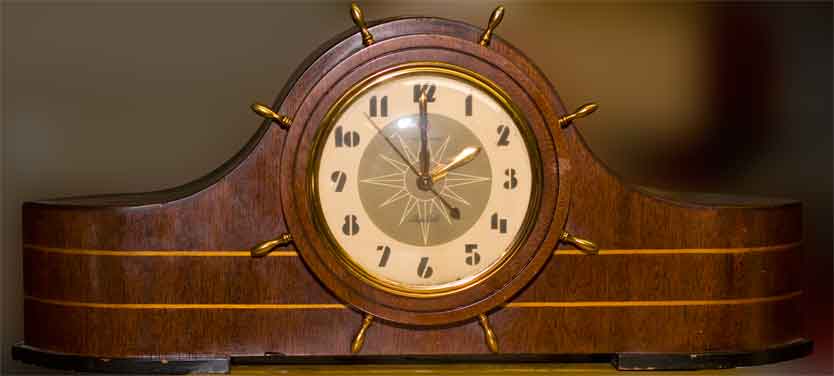General Electric got their hooks into Warren-Telechron at some point—I'm not sure when. They acquired them fully around the end of World War II when Henry Warren retired and sold out; but GE was making a line of clocks with Telechron movements before that.
Early GE/Telechrons are still desirable. Later ones suffered from soft sales due to competition from battery-powered movements, and the inevitable cost-cutting that went with trying to keep the division profitable.
They used a "smart" model number system (at least for awhile). For instance, this a 6B06. The 6 means it's from the 6 series, which is striking clocks (strikes but no chimes). The B is the type of rotor (the major electrical part of the motor. There are a few different types). The last two digits are the identifier of this particular clock style. A 6B01 has a square cabinet with horizontal accent stripes, the 6B06 is similar but has vertical accent stripes, the 6B05 is a rounded top, giving it an old fashioned tombstone appearance, my 6B06 is a "ship's bell" model with the nautical wheel spokes around the front, the 6B07 is a tambour, and so on.

This is a "ship's bell" clock, not just because it says so on the dial, but because it actually uses ships' bells for the strike. If you aren't familiar with the system, it's simple enough. It measures out a 4-hour "watch" (duty cycle) in ½-hour increments, one bell for each. If you start the watch at 12 o'clock, then it strikes once at 12:30, twice at 1 o'clock, three times at 1:30, and so forth until you get to eight bells at 4 o'clock; then the cycle starts over. There are six watches in a day.
My father has a ship's bell clock and it's a charmer, but it's in a round brass case with a screw-on dial cover, which is difficult enough to deal with ordinarily but made worse because the case is cracked and it's almost impossible to get the thread started. It would be great for an electric clock, but it's stupid on an 8-day spring-driven movement. Point is that it never gets wound.
I don't care much about nautical stuff; I wanted this because while I like Westminster chimes, I'm tired of them—they're to chimes as "Jingle Bells" is to Christmas carols; so I wanted something that wasn't a traditional strike or chime (cuckoo clocks don't count). I also like the idea of being able to tell what time it is in the middle of the night without having to find my glasses just so I can glance at the clock. Right now I listen to my clocks, but all of my clocks have traditional strikes. If I hear one gong, it could be 1 AM, or it could be any half-hour within, say, a six-hour block. With ship's bells you can pretty much figure out the time by counting the strike—even if you're half asleep.
I have no earthly idea why they named it a Gloucester. I'm trusting Telechron.net's accuracy for this. It's also from this website that I know it's from 1939. My particular clock I'm renaming "The Disappointment", and it may be the single biggest disappointment I've had buying clocks. What passes for the bell is a mess, so much so that it doesn't ring, it clacks. It sounds like a spoon tapping on an empty can of cat food.
It reminds me of the episode of The Bob Newhart Show (I haven't identified the episode title yet) where they buy a grandfather clock at an estate sale or some-such; it's got a beautiful chime but follows up with ka-Lunk as the strike gongs.
The bell that came with this clock had a tear, as if someone tried pulling it out with pliers. . There's a YouTube video of the same clock, which has a better looking bell, but the tone on that still leaves a lot to be desired. Even when the bell was in new condition, the tone was awful. It sounds like a spoon hitting a tin can lid. I ended up replacing it with an old typewriter bell, which sounds far better.
But — — there's an article on eBay called Telechron Chime Clocks Won't Strike. Yup—mine has this problem too. The conclusion of the article is there's no apparent fix to it. You either live with it or you turn the striker off. My father said he thought we might be able to re-engineer it to fix the problem, but it would be a huge amount of work—more than I was willing to do. So now it's just an objet d'art on my shelf.
Acquired: 2016 from an online auction site (can't remember which). ($30 or so)
Current condition: Would run if I plugged it in, but suffers from the same chime problem all these do, where the first two bells blur together.
